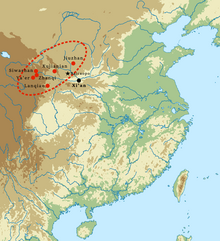 Area map of the Siwa culture, with main sites ( | |||||||
| Geographical range | upper Yellow River | ||||||
|---|---|---|---|---|---|---|---|
| Period | Bronze Age | ||||||
| Dates | c. 1300 – c. 600 BCE | ||||||
| Preceded by | Majiayao culture Qijia culture | ||||||
| Followed by | Ordos culture Shajing culture Han dynasty | ||||||
| Chinese name | |||||||
| Simplified Chinese | 寺洼文化 | ||||||
| |||||||
The Siwa culture (Chinese: 寺洼文化; pinyin: Sìwā wénhuà, ca. 1350-650 BCE)[1] was a Bronze Age culture in southeast Gansu Province, China. It was discovered by Swedish geologist Johan Gunnar Andersson in 1924 at Mount Siwa (寺洼山) in Lintao County, hence its name.[2] It flourished circa 14th to 11th century BC,[3] it is tentatively attributed to the cultures of the Northern Di, Qiang, and Xunyu peoples.[4][5]
The archaeological culture is divided into two phases: the early phase associated with the sites at Lintao, Zhuoni, Lintan, and Heshui; and, the final phase during the late Shang and proto-Zhou periods associated with the Jiuzhan, Xujianian, and Lanquiao sites.[6] Siwa culture is known for producing a type of pottery that had saddle-shaped mouths.[6]
- ^ Cite error: The named reference
TKwas invoked but never defined (see the help page). - ^ These sites are also called Miaopingyagou yizhi 庙坪鸦沟遗址.
- ^ "灞陵桥寺洼遗址成为全国重点文物保护单位--中国甘肃网". Archived from the original on 2012-03-16. Retrieved 2011-01-11.
- ^ Hu, Qianying 胡謙盈, "Lun Siwa wenhua" 論寺洼文化, Wenwu jikan 文物集刊 2 (1980), 123-4 of 118–24. Cited in Li, Feng (2006), Landscape And Power In Early China, Cambridge University Press. p. 187
- ^ 甘肃日报 [Gānsù Rìbào, Gansu Daily]. 《走进临洮县寺洼文化遗址》 [Zǒujìn Líntáoxiàn Sìwā Wénhuà Yízhǐ; "Entering Lintao County's Siwa Ruins"]. 2007. Accessed 17 Dec 2013. (in Chinese)
- ^ a b Linduff, Katheryn M.; Sun, Yan; Cao, Wei; Liu, Yuanqing (2018). Ancient China and its Eurasian Neighbors: Artifacts, Identity, and Death on the Frontier, 3000–700 BCE. New York: Cambridge University Press. p. 168. ISBN 978-1-108-41861-4.
